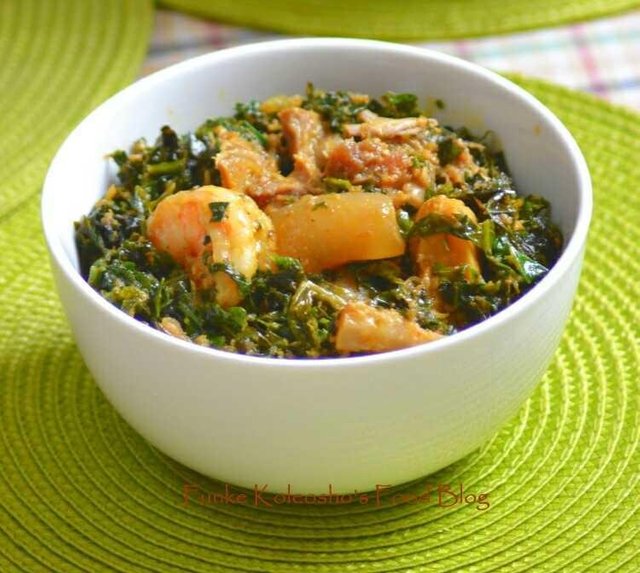The King Of Soups
The smell of seasoned meat wafts through the air into eager nostrils, the peculiarity of the sleek feel of the seafood doesn't go unnoticed either as it touches the tongue and the freshness of finely chopped vegetables bonding many different ingredients registers in the senses as the mixture burns a path down the eater's throat. For once the tastes of the many different ingredients seem distinct enough but the uniqueness of the blend that lingers on the tongue makes it difficult to differentiate. And so the eater belches and smiles, satisfied, grateful...alive!
Originating from the Efik and Ibibio speaking parts of Nigeria — Akwa-Ibom and Cross River, this delicacy, fit for a king's meal, ranks among the top vegetable soups of different tribes in any kitchen today; Eforiro, Afang, etc. Best stored frozen, this dish is a great option for holidayers who look to up on vitamin intake whilst maintaining a perfect physique and enjoying the tropics.
The uniqueness of this soup however, comes in the preparation. Unlike its vegetable related counterparts, constituents other than the original ones have been tried overtime and although different tastes were created, the richness and finesse is retained. While other vegetable soups may require a particular sort of leaves, ingredients et al for an almost same taste as the original of native cooks, the Edikang Ikong soup offers quite a variety of constituents to choose from, thus making room for creativity and passion.
But like every other thing involving an aberration from the norm, the introduction of new preparatory styles by other tribes have corroded the original methodological preparation of natives, thereby resulting in many different tastes contrasting with the original. Although this in no way undermines the creativity that comes with the new introductions, its effect on the cultural attachments of the dish is adversely affected.
In this vein, it would only be prudent to bring to light a few of the many different misconceptions that have arisen from the introduction of new techniques. Many a people have tried using okazi leaves and spinach as a substitute for the traditional water leaf and pumpkin leaves owing to ignorance on the use of the latter by natives and difference in tastes. Water leaf as used by natives serves not only the purpose of nutrition but also, quantity and thickness. As the name implies, this vegetable is vital in the regulation of the water balance of the soup.
While the Edikang Ikong isn't a watery soup, the water leaf is a way of adding just about enough water while the pumpkin leaves lend desired thickness by soaking up excess water given off by the water leaf, a feature not seen in the okazi leaves and spinach combo. Hence, making the okazi and spinach prepared soups quite runny after preparation.
Also, there exists somewhat of a cultural bias in the water leaf and pumpkin leaf ratio, making people favour a higher quantity of the latter during preparation. This however, contrasts with the view of natives who favour a higher ratio of the former. The frying of water leaf in palm oil is also a new technique not in the original scheme. This is because by frying the leaves, the water giving factor is somewhat reduced and the soup becomes thicker than normal, requiring constant addition of water which may cause a fluctuation in taste and look.
Summed up, a rich Edikang Ikong soup should maintain the image crafted by its creators. This can be achieved by sticking to the routine of the natives; by using yellow peppers instead of the all too common blended chilli pepper and tomato paste; adding chopped water leaf to the boiling meat and oil sauce and the pumpkin leaves only when the former is boiled enough, and not together or in quick successions; and using just enough palm oil.
It's an incredulous discovery knowing that the natives do not add onions except in the boiling of the meat. Ground crayfish and well cooked meat are seen as good enough taste boosters and the use of stock cubes is optional.
Probably wondering how you've been cooking this delicacy wrong the whole time? Well, there's always room to start over more intelligently.
Photo credit: funke-koleosho.blogspot.com
